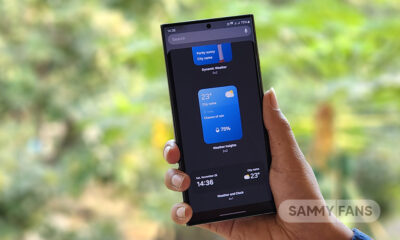Phones
These Google Pixel 7 renders show evolution of design language initiated by Google
A few months after the launch of the Pixel 6 and Pixel 6 Pro, the first renders showing the Pixel 7 Pro came out. The images from trusted leaker Onleaks show (CARHP) the evolution of the design language introduced by Google with the Pixel 6.
Judging by the images, the Pixel 7 looks similar to Pixel 6 and 6 Pro. The changes are subtle, for instance, the rear camera visor now integrates with the frame instead of sitting. Other changes related to the dimensions, the Pixel 7 Pro is estimated to be smaller, thinner, and narrower than the 6 Pro.
It is expected the same 6.7-inch to 6.8-inch curved display, single USB-C port, and dual speakers coming back. The power/lock and volume rocker buttons are on the right. The power/lock button is placed above the volume rocker button, but this is a pixel phone.
![]()
However, Google kept the original Pixel design for three generations and eight smartphones, while the Pixel 4 style continues for two generations and up to six smartphones.
Apart from these images, some other Pixel 7 details have come to light from hidden codes in the Android 13 developer preview. The phone is said to be equipped with Google’s Tensor 2 chip paired with the new Samsung Exynos modem.
![]()
The Pixel 6 is likely to have insufficient signal performance as a result of the current Exynos modem compared to Samsung and Apple phones that use Qualcomm modems. Hopefully, the new modem will help greatly in improving this.
Google’s Pixel 7 and Pixel 7 Pro are set to launch this October. While Google generally does not make its advance announcements, more details should come out before then.
![]()
Get notified –
Aside from SammyFans’ official Twitter and Facebook page, you can also join our Telegram channel, follow us on Instagram and subscribe to our YouTube channel to get notified of every latest development in Samsung and One UI ecosystem. Also, you can follow us on Google News for regular updates.
Phones
Sorry Sony, Apple iPhone set to use 48MP Samsung camera

After OLED, Samsung is entering Apple’s CIS supply chain. Ming-Chi Kuo today revealed that Samsung could start shipping 48MP camera for Apple iPhone models as early as 2026. It’s a big blow to Apple’s conventional image supplier, Sony.
For years, Sony has dominated Apple’s iPhone camera supply chain. The entry of Samsung in the Apple iPhone 48MP camera supply is certain in early 2026. The source mentioned that Samsung had to form a dedicated team to serve Apple.
As Samsung’s supply could start in 2026, the iPhone 16 and iPhone 17 may still use Sony sensors. As the Korean tech giant preps for supply, Apple may have considered completing its agreement/contract with Sony for the iPhone camera.
Ming-Chi Kuo’s article reads:
- Samsung is expected to begin shipping 1/2.6-inch 48MP ultra-wide CMOS image sensors (CIS) to Apple for iPhones as early as 2026, breaking Sony’s years-long monopoly on supplying CIS to Apple. To this end, Samsung has established a dedicated team to serve Apple.
The gap of nearly two years would result in some changes in camera supply. The iPhone maker may also opt for a multi-vendor strategy to freeze prices. Having more than a single supply chain partner empowers the manufacturer during price negotiation.
Kuo notes that Samsung will supply a 1/2.6-inch image sensor for iPhone. The product will have a 48-megapixel resolution. It will likely be used as an ultra-wide camera in future iPhones, while others will still be from Sony.
Phones
Honor Magic V3 is here to rival Galaxy Z Fold 6 with thinner design, nice specs

Samsung announced its most anticipated foldable phones on July 10 in Paris. Yesterday, Honor launched the new Magic V3, which challenges the Galaxy Z Fold 6 with a thinner design and some cool specs. The new Honor foldable is considerably thin compared to the phones available.
Honor’s new Magic V3 measures 9.2mm (camera bump not included) in its folded state. It goes further slimmer to 4.35mm when you unfold its 7.92-inch main screen. Oops, there’s a clearly visible hole for the camera on the inner display, with Galaxy Z Fold 6 featuring UDC for years.
The Chinese vendor managed to make its new foldable slimmer with an upgraded hinge of 2.84mm thickness. It won’t break before 500,000 folds while the frame is made from 7-series aluminum alloy. It’s the most highlighting spec that makes it superior to its Samsung counterpart.
Samsung reduced the weight of the Z Fold 6 to 239 grams but the Magic V3 weighs just 226 grams. Honor also brought IPX8 water resistance to the Magic V3, making it the first in the lineup to feature official protection against water insertion.

Galaxy Z Fold 6 packs a 4400mAh battery, but Honor’s Magic V3 has an edge here too. It boasts a 5150mAh silicon-carbon battery with 66W wired and 50W wireless charging. Both devices use Qualcomm’s Snapdragon 8 Gen 3 chipset, offering robust performance and efficiency.
Honor Magic V3 comes with a 6.43-inch LTPO cover screen with FHD+ resolution. It’s also rated for 2,500 nits peak brightness and supports stylus input. Notably, the Galaxy Z Fold 6 also supports S Pen input but on the inner panel only with a special pen crafted by Samsung.
In terms of optics, the Magic V3 features a 50MP primary with OIS, a 50MP Periscope with 3.5x optical zoom, and a 40MP ultrawide camera. The cover and main screens also house 20MP front-facing cameras. It lacks under-display camera technology which arrived 3rd time on a Samsung Fold.
Phones
Samsung launches Galaxy Z Flip 6 Olympic Edition for Athletes at Paris 2024

Samsung has unveiled the Galaxy Z Flip 6 Olympic Edition, a bespoke smartphone designed exclusively for athletes competing in the Paris 2024 Olympic and Paralympic Games. It will be provided to around 17,000 athletes participating in Paris 2024.
Samsung Galaxy Z Flip 6 special edition smartphone introduces Galaxy AI in an Olympic Edition to enhance athletes’ efficiency and connectivity throughout their Paris journey.
This smartphone features a striking yellow design adorned with iconic Olympic rings and Paralympic agitos in gold. By collaborating with Parasina Men’s luxury Maison Berluti, Samsung has designed a unique Flipsuit Case made from Venezia leather, inspired by the Olympic rings.

Each device comes with 100GB 5G eSIM data and two years of international warranty. Athletes will receive their Galaxy Z Flip 6 Olympic Edition from July 18 with pre-loaded Paris 2024-themed apps and exclusive services
Samsung Galaxy Z Flip 6
Samsung just launched Galaxy Z Flip 6 with a 6.7-inch Dynamic AMOLED 2X display, Qualcomm Snapdragon 8 Gen 3 Processor, 50MP main camera, 4000mAh battery, latest software, IP48, and more. Check full specs below.
Samsung Galaxy Z Flip 6 launches with bigger battery, 50MP camera and AI










